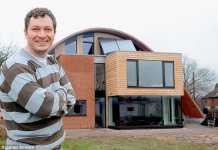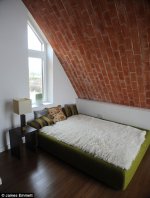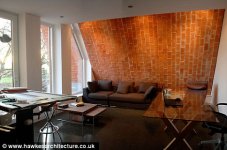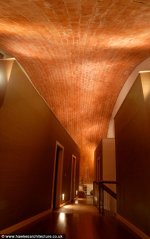http://www.dailymail.co.uk/sciencet...m-house--straight-medieval-drawing-board.html
It's the house that decades of design and centuries of building have been leading up to... but it takes its inspiration from the Middle Ages.
Strange as it may sound, this home of the future, designed for his family by architect Richard Hawkes, is wedded to the past.
Its very framework is based on a medieval design, known as timbrel vaulting, which can be seen in the dome-shaped roof.
First used in 1382 in Spain, this method uses thin bricks to create a lightweight,
durable building.
The arch is less than 5in thick, so wastes no material. Gravel and soil on top, in which flowers will be planted, help weigh the self-supporting frame down, stabilising it.
Not only does the structure do away with the need for materials such as concrete, which are energy intensive to make, it also allows the building to retain heat.
And in his quest to save power, Mr Hawkes again found traditional methods were best.
He used locally-sourced, old-fashioned clay tiles, in place of brick, as they were more energy efficient.
It has taken a year and £800,000 to build Crossways, in Staplehurst, Kent.
Mr Hawkes, his wife Sophie, 35, an investment banker, and their son Oscar, eight months, lived in a caravan on site before moving in.
But they should soon start recouping their costs. Solar panels on the roof generate 3,600kwh of energy a year meaning that there is no need to buy in power.
In fact, they should make £2,000 a year both from selling excess back to the National Grid and from grants for those who make their own energy.
And they won't waste the power they do use. Heat captured by the solar panels is transferred to a unique storage system.
It holds energy in a specially-developed salt which changes from a solid to a liquid to conserve heat. Developed with Cambridge University, the system stores seven times as much energy as a modern boiler, but is much smaller.
Air then moves through the system, is heated and is circulated round the house through vents, meaning there's no need for a radiator.
Even the floor, made of crushed glass bottles, is porous, so it stores heat.
It's the house that decades of design and centuries of building have been leading up to... but it takes its inspiration from the Middle Ages.
Strange as it may sound, this home of the future, designed for his family by architect Richard Hawkes, is wedded to the past.
Its very framework is based on a medieval design, known as timbrel vaulting, which can be seen in the dome-shaped roof.
First used in 1382 in Spain, this method uses thin bricks to create a lightweight,
durable building.
The arch is less than 5in thick, so wastes no material. Gravel and soil on top, in which flowers will be planted, help weigh the self-supporting frame down, stabilising it.
Not only does the structure do away with the need for materials such as concrete, which are energy intensive to make, it also allows the building to retain heat.
And in his quest to save power, Mr Hawkes again found traditional methods were best.
He used locally-sourced, old-fashioned clay tiles, in place of brick, as they were more energy efficient.
It has taken a year and £800,000 to build Crossways, in Staplehurst, Kent.
Mr Hawkes, his wife Sophie, 35, an investment banker, and their son Oscar, eight months, lived in a caravan on site before moving in.
But they should soon start recouping their costs. Solar panels on the roof generate 3,600kwh of energy a year meaning that there is no need to buy in power.
In fact, they should make £2,000 a year both from selling excess back to the National Grid and from grants for those who make their own energy.
And they won't waste the power they do use. Heat captured by the solar panels is transferred to a unique storage system.
It holds energy in a specially-developed salt which changes from a solid to a liquid to conserve heat. Developed with Cambridge University, the system stores seven times as much energy as a modern boiler, but is much smaller.
Air then moves through the system, is heated and is circulated round the house through vents, meaning there's no need for a radiator.
Even the floor, made of crushed glass bottles, is porous, so it stores heat.
Attachments
-
 article-1148302-038EBB5D000005DC-571_468x324_popup.jpg88.9 KB · Views: 35
article-1148302-038EBB5D000005DC-571_468x324_popup.jpg88.9 KB · Views: 35 -
 article-1148302-038EC3AC000005DC-985_468x354_popup.jpg137.4 KB · Views: 37
article-1148302-038EC3AC000005DC-985_468x354_popup.jpg137.4 KB · Views: 37 -
 article-1148302-038D84C4000005DC-782_468x616.jpg72 KB · Views: 34
article-1148302-038D84C4000005DC-782_468x616.jpg72 KB · Views: 34 -
 article-1148302-038E0945000005DC-672_468x678.jpg68.9 KB · Views: 37
article-1148302-038E0945000005DC-672_468x678.jpg68.9 KB · Views: 37 -
 article-1148302-038FB1AB000005DC-338_468x310.jpg47.5 KB · Views: 35
article-1148302-038FB1AB000005DC-338_468x310.jpg47.5 KB · Views: 35 -
 article-1148302-038FB1B3000005DC-906_468x743.jpg72.9 KB · Views: 39
article-1148302-038FB1B3000005DC-906_468x743.jpg72.9 KB · Views: 39
